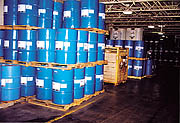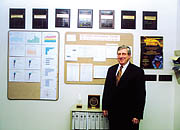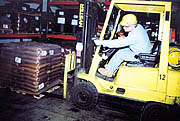QS-9000 Drives Continuous Improvement for Chemical Distributors

But on this visit, cooperation was the watchword. The CHEMCENTRAL executives were on a benchmarking mission. A division of PVS Chemicals Inc., an international chemical producer, PVS Nolwood had implemented one of the most advanced bar coding systems in the industry to manage its inventory. CHEMCENTRAL, a billion-dollar corporation with 39 branches in North America, was there to see the bar coding system in action.

QS-9000 is Driver
The mission was largely driven by the fact that both companies are registered to QS-9000, the quality management system standard derived from ISO 9000.Developed by the automotive industry to meet its special needs, QS-9000 is a more challenging standard than its forerunner. It has up to 383 requirements (“shall statements”), as opposed to up to 137 for ISO 9000. The fact that both companies had registered to QS-9000 testified to their recognition of the importance of quality. According to Ken Jaggers, CHEMCENTRAL’s vice president, Compliance and Quality, the company adopted the standard because “our research showed QS-9000 gave more return on investment.” Dick Peacock, Nolwood’s president, expressed similar sentiments: “To keep our business growing in a marketplace that’s not growing, we have to provide the highest level of service attainable. QS-9000 is critical to that.”
QS-9000 is not only challenging to implement and register to, it also poses an ongoing challenge in that continuous improvement is a key requirement. It’s not enough to manage inventory effectively or process orders efficiently, a QS-9000 company also must continually seek out ways of improving those processes. This drive toward continuous improvement was a crucial driver behind CHEMCENTRAL’s interest in bar coding and the benchmarking mission.
In part, PVS Nolwood was paying back a debt, since it had previously benchmarked with CHEMCENTRAL when it was looking to implement an enterprise resource-planning (ERP) system. Sharing of information between chemical distributors is also encouraged by the industry’s Responsible Distribution Code (RDC), to which both Nolwood and CHEMCENTRAL subscribe as members of the National Association of Chemical Distributors (NACD). Both companies have integrated their responsible distribution process (RDP) procedures, which establish requirements for health, safety and the environment, into their QS-9000 systems. The NACD’s guiding principles specifically call upon members to promote RDP principles by “sharing experiences and offering assistance to others who produce, handle, transport, or dispose of chemicals.”
Bar Coding Basics
The setting for CHEMCENTRAL’s introduction to bar coding was Nolwood’s Detroit headquarters, the worldwide headquarters of the PVS organization. Representatives from the two companies and other interested observers reviewed Nolwood’s implementation of, rationale for and experience with the bar coding technology.In bar coding, information is automatically coded in a sequence of lines of various widths and configurations on a label, which is affixed to each item as it enters the system. Each array or bar code can be read by a handheld scanner or reader, which uses laser light to translate the code first into optical impulses and then into the computer language, ASCII, which is entered into a database. Once in the database, the information can be accessed by any business application.
Nolwood uses the bar code system throughout its warehousing, inventory and supply chain management processes to manage distribution, shipments, and payments. The system uses Intermec equipment.
“We can take an order in our customer service department for the product that we need to ship in three weeks, determine whether we have the product in inventory, identify which lots we’ll use to fill the order, fax the customer a certificate of analysis [which gives the customer a chemical analysis of a given lot] for the lots we’ll ship while the customer is on the line, and then electronically block the warehouse from shipping the wrong order,” explained Dick Peacock.
“That makes it think proof, mistake proof,” said Mike Gallagher.
“Although we had problems at first when we switched over in 1998, it’s worked well since we got the bugs out of it,” Peacock said. “It’s key to inventory control. We cycle count a little everyday, so that over the year we count between 12 and 15 times. Arthur Anderson, our accountant, accepts the validity of the cycle count so we don’t have to do an annual inventory. That saves some time and money, but more than that it shows the system is under control.”
“It’s also valuable for confirming shipments,” said Peacock. “You know how many times your customer doesn’t want to pay because they don’t think they got the shipment. When the signed receipts come back we scan them in and then, when there’s a question, our customer service reps can use the bar code to retrieve an electronic copy of the signed shipper and fax it back right from their desk. We don’t even file them by customer — we just batch file by date.”
One of CHEMCENTRAL’s biggest problems, explained Dave Beattie, is tracking lot numbers, since about 25% of customers want shipments in complete lots to ensure uniformity. There may be 300 drums of a product from different lots jumbled up. To get to the drums from the right lot sorted out can be a challenge. This is a problem that bar coding can solve.
“Once the lot number is automatically assigned it shows up on anything from there on out,” said Melissa delaGarza, Nolwood’s manager of Customer Service. “So the bar code system has helped us learn to live with lot numbers. We can see in the inventory right away if we can complete an order from a single lot for the customers who request it. We also know right where each lot is in the warehouse. We see a trend toward tracing product by lot number.”

In the Field
To see the system in action, the Benchmarking team moved to PVS Nolwood’s warehouse in a commercial section of Detroit. Nolwood has grown consistently and incrementally, enveloping adjacent properties. “We have four addresses connected now and we’re looking to buy the building next door,” said Peacock.During a spirited discussion, important details about Nolwood’s bar code system emerged.
- The cycle counting process turns up 10 to 12 corrections a week. Broken pallets and the consequent mixing of lots are the most common problems.
- Negative inventories are a constant challenge.
- The system tracks 1,000 products and grades of products with 5,000 lot numbers in inventory.
- The volume through the warehouse each week is about 80 million pounds.
- Based on forecasts, replenishment is done on weekly intervals.
In the warehouse, orders are filled at night. Loaders receive a “pick sheet,” which gives them instructions by way of bar codes. It tells them where products are located — the warehouse is organized by “location” — products, amounts, lot numbers, customer code. Each loader uses a scanner first to read the pick list, then to find the product, which he selects and loads. If a loader scans in the wrong product, he gets an error message. In theory, the system is mistake proof.
“This system gives us much more control,” said Ron Watkins, who has worked as a loader and truck driver for 14 years at Nolwood. “Before you had to remember where everything was. Now the bar code gives you the location, so you don’t have to depend on your memory or search around to find something because someone has moved things around.”
Continuous Improvement
The visitors from CHEMCENTRAL were convinced that bar coding would help their company. “No doubt it would improve efficiency and increase productivity,” Gallagher said. “We’d spend a lot less time preparing an order.”“It would give us higher quality information and data, if we had bar coding,” Beattie added. “We’d know up front where the product was going to come from and how it’s going to be loaded before we even went to the warehouse. Knowing where everything is to begin with is a huge advantage.”
“I’m sure it improves their service to the customer and they are more profitable as a result,” said Gallagher. “It’s a great example of continuous improvement. It’s QS-9000 in action. I expect CHEMCENTRAL will begin to look very seriously at implementing a similar system. It would be a big financial commitment for us and we’d have to integrate it with our current systems, so it won’t happen overnight. It’s a matter of weighing the costs against the benefits. We spent a year researching before deciding to go ahead with QS-9000. No doubt we’ll exercise similar care in regard to bar coding.
Nolwood embraced bar coding primarily to reduce human error, which results from the natural human difficulty in distinguishing between similar chemicals. This issue was magnified by the challenges inherent in the need to maintain and track lot numbers for certain chemicals for key customers.
“Eliminating errors gave us a competitive advantage,” said Dick Peacock. “Important customers care about lot traceability because it enables them to eliminate a potential error in their own operation. If they have a problem, they know it’s not because of the variability in the chemicals they got from us. Bar coding our inventory is part of continuous improvement which we’re formally committed to by QS-9000 and RDP.”
Service Reporting System
Nolwood knows that bar coding reduced errors, because the company has developed a sophisticated Service Report System, which tracks error rates. In this system, every problem ranging from a leaky drum to a late shipment to a customer complaint to a failure of one department to communicate with another is reported. Anytime anything isn’t perfect, it’s entered into the Service Report System, which is accessible at computers throughout the organization. Everyone has access to the system and everyone is encouraged to enter reports. The process captures on average 300 reports per month. It’s a highly developed non-conformance reporting system, which is part of correction action, Element 4.14.2 in QS-9000.“Since introducing bar coding, shipping errors in general have dropped 35%,” said Phyllis Baca-Flores, manager of Quality Systems, who created the Service Report System. “Inventory levels have also really improved. The percentage of back orders that we can control has been reduced by half. We no longer see any back orders that result from product error.”
Nolwood’s Service Report System produces an array of information not only about Nolwood’s performance but also about the performance of Nolwood’s customers and vendors. Reports from the system are broadly distributed to both customers and suppliers who need and want to know where they are having problems. Suppliers want to see how they stack up. The information provided by the Service Report System provides benchmarks that are helpful to many who work with Nolwood.
“QS-9000, bar coding, and the service report system combine to make us more predictible, more accurate, and more responsive,” said Dick Peacock. “That’s what it’s all about. Our business is growing in a marketplace that’s not. Our margins are growing in a marketplace where margins are typically shrinking, because our customers are willing to pay for the premium level of service we provide. Quality pays.”
Eagle Group USA Inc. is a training and consulting company based in Troy, MI, that specializes in applying management systems. Clyde Pearch can be reached at 800/508.9044 or by e-mail at clientservices@eaglegroupusa.com.
Looking for a reprint of this article?
From high-res PDFs to custom plaques, order your copy today!







